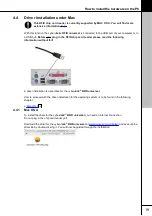
cyberJack® RFID universal manual
26
The interruption of communication with the PC is software-controlled by means of a lock which ensures
that in the Secure PIN input mode no data are transmitted from the memory (PIN data). Only log
information is transmitted to the PC which is always transferred directly to the hardware interface in the
form of constants.
Should the chip card reader indeed switch to the routine for PC communication owing to a malfunction,
the Secure PIN input mode is identified there and the switch made to the "Stop" security routine. In
this routine the chip card reader is reinitialised, the entire Interrupt system is switched off and the
yellow LED flashes in synchrony with the blue Duo LED. The only way to exit is by unplugging the chip
card reader and plugging it in again.
Communication separation cannot be influenced from the outside via interfaces.
Reprocessing
The reprocessing security function reprocesses the area of the memory in which the PIN data are
buffered during the Secure PIN input mode (the storage locations of the PIN data are overwritten with
zeros). This prevents PIN data in the temporary memory from being read out.
The area of the memory is overwritten with zeros before communication with the PC is restored (after
the secure PIN input). This takes place both after the PIN data have been successfully transmitted to
the contact-type signature-creation unit (chip card) of if the PIN input is cancelled by the user or by a
timeout.
During Secure PIN input, if an error occurs followed by a system start the relevant memory area is
reinitialised thus also deleting any PIN data present.
By overwriting the memory locations of the PIN data with zeros the cyber
Jack
®
RFID universal
guarantees that these data are no longer contained in the memory areas and therefore - when the
Secure PIN input is finished - they cannot be read out.
Reinitialisation
The reinitialisation security function reinitialises the memory of the cyber
Jack
®
RFID universal
. This
is effected by overwriting the entire RAM with zeros. The one exception: a few bytes for the stack
memory and a few bytes for saving the status quo of the USB system. These are for the controller
function and therefore absolutely necessary for the system.
The security function is applied when the cyber
Jack
®
RFID universal
is started by inserting the chip
card reader into the PC, after a watchdog reset or after a control reset.
A watchdog reset takes place if faults - which have been caused intentionally or owing to technical
failure - occur in the functional process of the cyber
Jack
®
RFID universal
(especially due to
commands which cannot be interpreted) the watchdog timer is not reset within a certain time span and
the watchdog therefore triggers a controller reset.
After a reset by the watchdog the chip card reader is subsequently stopped and the yellow LED and
the blue Duo LED flash in synchrony.
When a normal start takes place the currently valid version number of the active firmware is shown in
the display of the chip card reader. The authenticity of the version displayed is indicated to the user by
the flashing yellow LED.
Command filter
With this function the cyber
Jack
®
RFID universal
prevents commands from being forwarded to the
chip card which are suitable for saving the PIN data on the chip card or for manipulating them.
Therefore within the "Secure PIN input" mode only those commands are forwarded to the chip card
which can be used for authentication purposes.
These are exclusively:
VERIFY
CHANGE REFERENCE DATA
DISABLE VERIFICATION REQUIREMENT
ENABLE VERIFICATION REQUIREMENT
RESET RETRY COUNTER
All other commands to the chip card are blocked by the chip card reader.
Released encryption methods
Released encryption methods are used for encrypted data communication and for secure downloading
(module update).





































